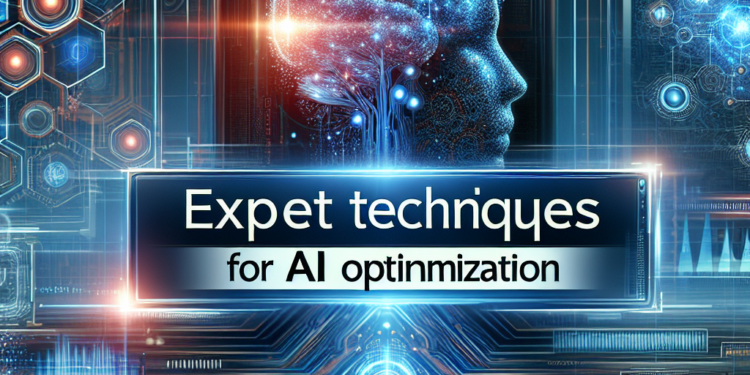With the rapid advancement of technology and the increasing demand for artificial intelligence (AI) solutions in various industries, the need for efficient AI optimization techniques has become crucial. AI optimization involves improving the performance and efficiency of AI algorithms to ensure they can deliver accurate and reliable results in real-world applications. In this article, we will explore some expert techniques for AI optimization that can help developers and data scientists enhance the performance of their AI models.
One of the key techniques for AI optimization is hyperparameter tuning. Hyperparameters are parameters that are set before the training process begins and can significantly impact the performance of an AI model. Hyperparameter tuning involves fine-tuning these parameters to find the optimal values that result in the best performance of the model. This can be done manually by adjusting the hyperparameters iteratively and evaluating the model’s performance, or using automated tools like grid search or random search to explore a wide range of hyperparameter values and find the best combination.
Another important technique for AI optimization is data preprocessing. Data preprocessing involves cleaning and transforming raw data into a format that is suitable for training AI models. This includes removing missing values, scaling and normalizing data, encoding categorical variables, and handling outliers. Data preprocessing is essential for improving the quality of the data and helping AI models learn more effectively from the data. By applying proper data preprocessing techniques, developers can improve the accuracy and efficiency of their AI models.
Feature engineering is another crucial technique for AI optimization. Feature engineering involves selecting, extracting, and creating new features from the raw data that can help improve the performance of AI models. This can include creating interaction terms, polynomial features, or transforming continuous variables into categorical variables. By engineering informative and relevant features, developers can provide more meaningful inputs to AI models and improve their predictive power.
Regularization is another important technique for AI optimization, especially for reducing overfitting in AI models. Overfitting occurs when a model learns the noise in the training data instead of the underlying patterns, leading to poor generalization and performance on unseen data. Regularization techniques like L1 and L2 regularization, dropout, and early stopping can help prevent overfitting by penalizing complex models and encouraging simpler models that generalize better. By incorporating regularization techniques, developers can improve the robustness and generalization of their AI models.
Ensemble learning is a powerful technique for AI optimization that involves combining multiple models to improve the overall performance. Ensemble learning can take different forms, such as bagging, boosting, or stacking, and can help mitigate the weaknesses of individual models and enhance their predictive power. By leveraging the diversity of multiple models and combining their predictions, developers can improve the accuracy and stability of their AI solutions.
Another expert technique for AI optimization is transfer learning. Transfer learning involves leveraging pre-trained models and transferring their knowledge to new tasks or domains. By fine-tuning pre-trained models on new data or using them as feature extractors, developers can reduce the amount of training data needed and accelerate the training process. Transfer learning is especially useful for tasks with limited data or computational resources and can help improve the performance of AI models in various applications.
Optimization algorithms play a crucial role in training AI models efficiently and effectively. Gradient descent is a fundamental optimization algorithm used in training neural networks and other deep learning models. By updating model parameters iteratively in the direction of the steepest descent of the loss function, gradient descent can optimize model weights and improve model performance. Advanced optimization algorithms like Adam, RMSprop, and Adagrad can further enhance the convergence speed and stability of training deep learning models.
Parallel computing and distributed training are essential techniques for scaling AI models to large datasets and accelerating model training. By leveraging multiple GPUs or distributed computing frameworks like TensorFlow or PyTorch, developers can train AI models faster and more efficiently. Parallel computing can also help handle the computational requirements of complex AI models like deep neural networks, enabling developers to experiment with larger models and datasets.
Model compression is another expert technique for AI optimization that involves reducing the size and complexity of AI models without compromising their performance. Model compression techniques like pruning, quantization, and knowledge distillation can help reduce the memory footprint and computational complexity of AI models, making them more efficient to deploy on edge devices or in resource-constrained environments. By compressing AI models, developers can improve inference speed, reduce power consumption, and enhance the scalability of their AI solutions.
Lastly, continuous monitoring and optimization are essential for ensuring the long-term performance and reliability of AI models in production. By monitoring model performance, data distributions, and other relevant metrics, developers can identify and address issues like concept drift, data shifts, or model degradation that can affect model performance over time. By continuously optimizing AI models and updating them with new data and feedback, developers can ensure their AI solutions remain effective and deliver accurate results in dynamic and evolving environments.
In conclusion, expert techniques for AI optimization play a critical role in improving the performance, efficiency, and reliability of AI models in real-world applications. By applying techniques like hyperparameter tuning, data preprocessing, feature engineering, regularization, ensemble learning, transfer learning, optimization algorithms, parallel computing, model compression, and continuous monitoring, developers and data scientists can enhance the accuracy, speed, and scalability of their AI solutions. By leveraging these techniques effectively, developers can unlock the full potential of AI technology and drive innovation in various industries.













